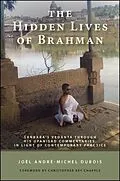Finalist for the 2014 Best First Book in the History of Religions presented by the American Academy of Religion
Säkara's thought, advaita vedanta or non-dual vedanta, is a tradition focused on brahman, the ultimate reality transcending all particular manifestations, words, and ideas. It is generally considered that the transcendent brahman cannot be attained through any effort or activity. While this conception is technically correct, in The Hidden Lives of Brahman, Joël André-Michel Dubois contends that it is misleading.
Hidden lives of brahman become visible when analysis of Säkara's seminal commentaries is combined with ethnographic descriptions of contemporary Brahmin students and teachers of vedanta, a group largely ignored in most studies of this tradition. Du bois demonstrates that for Säkara, as for Brahmin tradition in general, brahman is just as much an active force, fully connected to the dynamic power of words and imagination, as it is a transcendent ultimate.
Autorentext
Joël André-Michel Dubois is Professor of Humanities and Religious Studies at California State University, Sacramento.
Inhalt
Illustrations
Pronunciation of Sanskrit Words
Foreword
Preface
Abbreviations
1. Introducing Brahman: The Hidden Lives of Säkara's Vedanta Teaching
Part 1: Envisioning Brahman
2. Attending to Brahman: Upasana Practice Past and Present
3. Learning Brahman: The Daily Life of the Brahmacarin
4. Envisioning Veda: First-Person Declarations in Säkara's Upani ad Commentaries
Part 2: Imagining Brahman
5. Conditioning the Mind for Brahman: Säsk ta Training Past and Present
6. Perfecting the Life of Brahman: The Training of Säsk ta Pä ita
7. Perfecting the Vedic Imagination: Imagery and Rhetoric in Säkara's Upani ad Commentaries
Part 3: Perceiving Brahman
8. Thinking Deeply About Brahman: The Two Mimäsas, the Lost Art of Yajña, and the Hidden Structure of Brahman
9. Giving Up the Inconstant Brahman: Contemporary Sänyasins and Aspiring Renouncers
10. Discerning the Paradox of Veda: Ritual Activity and Insight in Säkara's Upani ad Commentaries
Conclusion: Brahman as Center and Periphery
Appendix: Diagrams of Key Concepts
Notes
Bibliography
Index
